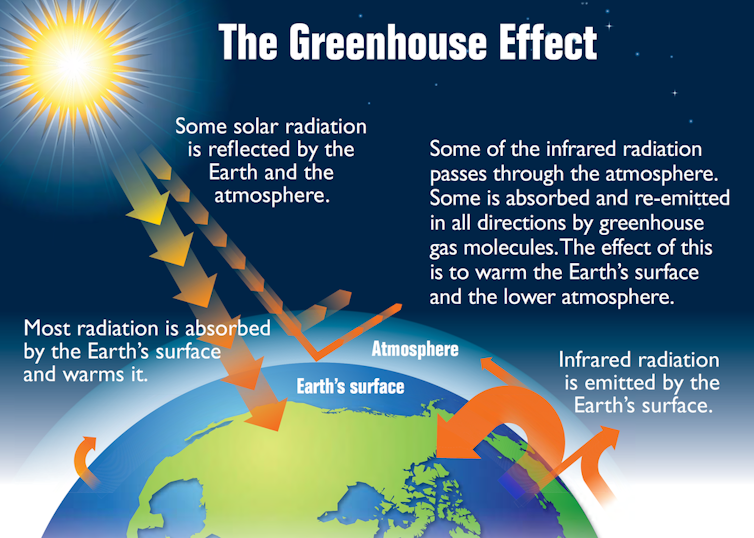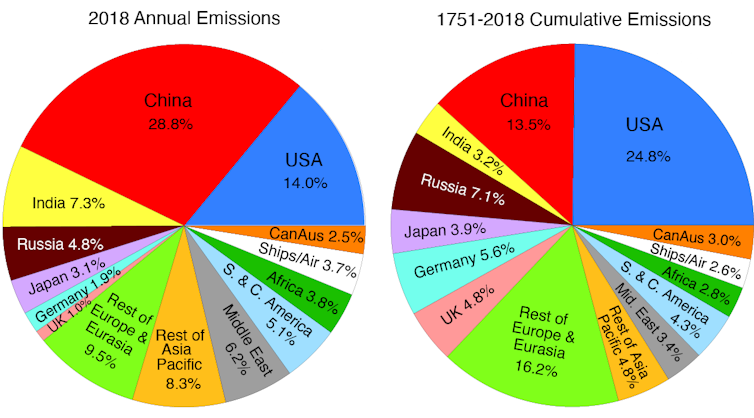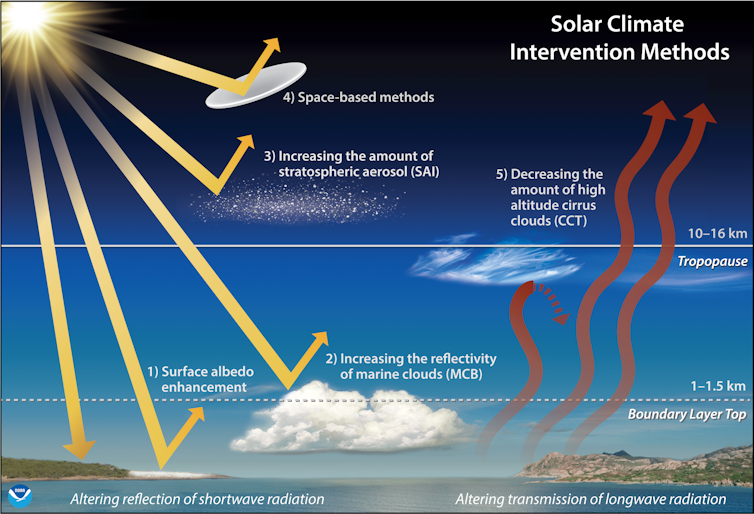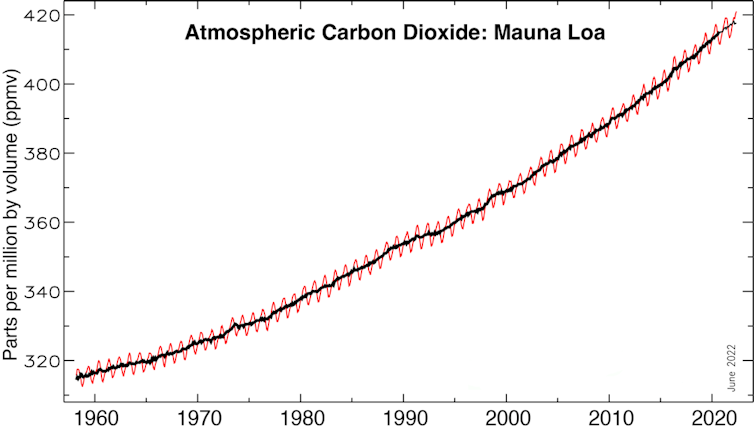How not to solve the climate change problem
Posted on 3 August 2022 by Guest Author
Kevin Trenberth, Distinguished Scholar, NCAR; Affiliated Faculty, University of Auckland. This article is republished from The Conversation under a Creative Commons license. Read the original article.
When politicians talk about reaching “net zero” emissions, they’re often counting on trees or technology that can pull carbon dioxide out of the air. What they don’t mention is just how much these proposals or geoengineering would cost to allow the world to continue burning fossil fuels.
There are many proposals for removing carbon dioxide, but most make differences only at the edges, and carbon dioxide concentrations in the atmosphere have continued to increase relentlessly, even through the pandemic.
I’ve been working on climate change for over four decades. Let’s take a minute to come to grips with some of the rhetoric around climate change and clear the air, so to speak.
What’s causing climate change?
As has been well established now for several decades, the global climate is changing, and that change is caused by human activities.
When fossil fuels are burned for energy or used in transportation, they release carbon dioxide – a greenhouse gas that is the main cause of global heating. Carbon dioxide stays in the atmosphere for centuries. As more carbon dioxide is added, its increasing concentration acts like a blanket, trapping energy near Earth’s surface that would otherwise escape into space.
When the amount of energy arriving from the Sun exceeds the amount of energy radiating back into space, the climate heats up. Some of that energy increases temperatures, and some increases evaporation and fuels storms and rains.
 How the greenhouse effect works. EPA
How the greenhouse effect works. EPA
Because of these changes in atmospheric composition, the planet has warmed by an estimated 1.1 degrees Celsius (2 F) since about 1880 and is well on the way to 1.5 C (2.7 F), which was highlighted as a goal not to be crossed if possible by the Paris Agreement. With the global heating and gradual increases in temperature have come increases in all kinds of weather and climate extremes, from flooding to drought and heat waves, that cause huge damage, disruption and loss of life.
Studies shows that global carbon dioxide emissions will need to reach net-zero carbon emissions by midcentury to have a chance of limiting warming to even 2 C (3.6 F).
Currently, the main source of carbon dioxide is China. But accumulated emissions matter most, and the United States leads, closely followed by Europe, China and others.
 Estimated shares of carbon dioxide emissions from fossil fuels in 2018 compared with cumulative emissions over time, based on data released by BP. Kevin Trenberth, Author provided
Estimated shares of carbon dioxide emissions from fossil fuels in 2018 compared with cumulative emissions over time, based on data released by BP. Kevin Trenberth, Author provided
What works to slow climate change?
Modern society needs energy, but it does not have to be from fossil fuels.
Studies show that the most effective way to address the climate change problem is to decarbonize the economies of the world’s nations. This means sharply increasing use of renewable energy – solar and wind cost less than new fossil fuel plants in much of the world today – and the use of electric vehicles.
Unfortunately, this changeover to renewables has been slow, due in large part to the the huge and expensive infrastructure related to fossil fuels, along with the vast amount of dollars that can buy influence with politicians.
What doesn’t work?
Instead of drastically cutting emissions, companies and politicians have grasped at alternatives. These include geoengineering; carbon capture and storage, including “direct air capture”; and planting trees.
Here’s the issue:
Geoengineering often means “solar radiation management,” which aims to emulate a volcano and add particulates to the stratosphere to reflect incoming solar radiation back to space and produce a cooling. It might partially work, but it could have concerning side effects.
The global warming problem is not sunshine, but rather that infrared radiation emitted from Earth is being trapped by greenhouse gases. Between the incoming solar and outgoing radiation is the whole weather and climate system and the hydrological cycle. Sudden changes in these particles or poor distribution could have dramatic effects.
 Some methods of solar radiation management that have been proposed. Chelsea Thompson, NOAA/CIRES
Some methods of solar radiation management that have been proposed. Chelsea Thompson, NOAA/CIRES
The last major volcanic eruption, of Mt. Pinatubo in 1991, sent enough sulfur dioxide and particulates into the stratosphere that it produced modest cooling, but it also caused a loss of precipitation over land. It cooled the land more than the ocean so that monsoon rains moved offshore, and longer term it slowed the water cycle.
Carbon capture and storage has been researched and tried for well over a decade but has sizable costs. Only about a dozen industrial plants in the U.S. currently capture their carbon emissions, and most of it is used to enhance drilling for oil.
Direct air capture – technology that can pull carbon dioxide out of the air – is being developed in several places. It uses a lot of energy, though, and while that could potentially be dealt with by using renewable energy, it’s still energy intensive.
 Boris Johnson, then mayor of London, plants a tree in 2008. Peter Macdiarmid/Getty Images
Boris Johnson, then mayor of London, plants a tree in 2008. Peter Macdiarmid/Getty Images
Planting trees is often embraced as a solution for offsetting corporate greenhouse gas emissions. Trees and vegetation take up carbon dioxide though photosynthesis and produce wood and other plant material. It’s relatively cheap.
But trees aren’t permanent. Leaves, twigs and dead trees decay. Forests burn. Recent studies show that the risks to trees from stress, wildfires, drought and insects as temperatures rise will also be larger than expected.
How much does all this cost?
Scientists have been measuring carbon dioxide at Mauna Loa, Hawaii, since 1958 and elsewhere. The average annual increase in carbon dioxide concentration has accelerated, from about 1 part per million by volume per year in the 1960s to 1.5 in the 1990s, to 2.5 in recent years since 2010.
This relentless increase, through the pandemic and in spite of efforts in many countries to cut emissions, shows how enormous the problem is.
 Carbon dioxide concentrations at Mauna Loa, Hawaii. The monthly mean, in red, rises and falls with the growing seasons. The black line is adjusted for the average seasonal cycle. Kevin Trenberth, based on NOAA data, CC BY-ND
Carbon dioxide concentrations at Mauna Loa, Hawaii. The monthly mean, in red, rises and falls with the growing seasons. The black line is adjusted for the average seasonal cycle. Kevin Trenberth, based on NOAA data, CC BY-ND
Usually carbon removal is discussed in terms of mass, measured in megatons – millions of metric tons – of carbon dioxide per year, not in parts per million of volume. The mass of the atmosphere is about 5.5x10¹? metric tons, but as carbon dioxide (molecular weight 42) is heavier than air (molecular weight about 29), 1 part per million by volume of carbon dioxide is about 7.8 billion metric tons.
According to the World Resources Institute, the range of costs for direct air capture vary between US$250 and $600 per metric ton of carbon dioxide removed today, depending on the technology, energy source and scale of deployment. Even if costs fell to $100 per metric ton, the cost of reducing the atmospheric concentrations of carbon dioxide by 1 part per million is around $780 billion.
Keep in mind that the carbon dioxide concentration in the atmosphere has risen from about 280 parts per million before the industrial era to around 420 today, and it is currently rising at more than 2 parts per million per year.
Tree restoration on one-third to two-thirds of suitable acres is estimated to be able to remove about 7.4 gigatons of carbon dioxide by 2050 without displacing agricultural land, by WRI’s calculations. That would be more than any other pathway. This might sound like a lot, but 7 gigatons of carbon dioxide is 7 billion metric tons, and so this is less than 1 part per million by volume. The cost is estimated to be up to $50 per metric ton. So even with trees, the cost to remove 1 part per million by volume could be as much as $390 billion.
Geoengineering is also expensive.
So for hundreds of billions of dollars, the best prospect with these strategies is a tiny dent of 1 part per million by volume in the carbon dioxide concentration.
This arithmetic highlights the tremendous need to cut emissions. There is no viable workaround.![]()































 Arguments
Arguments






























The Sun has entered a Grand Solar Minimun that will last from 2020 to 2053 and will cool the Earth. Solar irradiance has already started declining. The worst will be from 2028 to 2032 when crop failurs due to cold wet weather are widespread. The cold will cause the oceans to absorb CO2 and it will get colder. We are still in the 2.588 million-year ice age called the Quaternary Glaciation. The interglacial period is usually aboout 10,000 years. It has been 11,700 since the last glacial period which suggests that with the cold another 90,000 year glacial period might be starting.
I forgot to include the link to an article explaining the calculations and forecast.
'Modern Grand Solar Minimum will lead to terrestrial cooling
Valentina Zharkova'
https://www.tandfonline.com/doi/full/10.1080/23328940.2020.1796243
[BL] Link activated.
The web software here does not automatically create links. You can do this when posting a comment by selecting the "insert" tab, selecting the text you want to use for the link, and clicking on the icon that looks like a chain link. Add the URL in the dialog box.
scvblwxq1:
That particular paper by Zharkova was previously mentioned in the weekly Skeptical Science New Research post back when it appeared in 2020. Quoting from that post:
You can read about the previous paper in this thread at PubPeer:
https://pubpeer.com/publications/3418816F1BA55AFB7A2E6A44847C24#
and the retraction was noted at Retraction Watch. The blogger And Then There's Physics was involved in noting some of the many issues with the earlier paper, and wrote several blog posts on the subject:
https://andthentheresphysics.wordpress.com/2019/07/07/nature-scientific-reports/
https://andthentheresphysics.wordpress.com/2019/07/25/retract/
https://andthentheresphysics.wordpress.com/2020/01/13/zharkova-et-al-an-update/
https://andthentheresphysics.wordpress.com/2020/03/04/zharkova-et-al-retracted/
Zharkova makes a habit of beating this drum, and the results are rarely worth reading. To coin a phrase, this is nothing new under the sun.
[BL] Corrected third link to And Then There's Physics.
Scvblwxq1 , may I offer a couple of points to save you time (and you may wish to check them against the record of published scientific papers & expert views).
A / The length of interglacials varies considerably. You are correct in saying that an interglacial length does average somewhere around 10,000 years. Yet the present Milankovitch cycle has an unusually low level of ellipticity ~ which likely results in a long interglacial . . . thought to extend for 20-30,000 years (as best as can be judged from prior effects of the Milankovitch cycles during the past million years). In other words, the deep glaciation will next occur in something around 15,000 years from now.
So there is no need to hurry to warm our planet. And it has been estimated that the current (420ppm) level of atmospheric CO2 has already exceeded the level required to make a major postponement in the next glaciation that you were worried about. A postponement of some tens of thousands of years. And so the present-day concern is the adverse effects of the current rapid global warming.
B / Will the proposed Grand Solar Minimum have a (beneficial) cooling effect on planetary temperatures? Evidently not ~ for a GSM typically will produce a global warming of 0.5 degrees or less : and that effect will be insufficient to counter our ongoing AGW of approx 0.18 degrees per decade. Sorry, but there is more warming ahead (even if Prof. Zharkova's very uncertain predictions of GSM turn out to be mostly correct).
Typo correction from @4 :
(last paragraph)
... a GSM typically will produce a global cooling of 0.5 degrees or less ...
!!!
For what it is worth, RealClimate also has an older post (March 2020) on bad papers in the "Climate change is caused by solar radiation" subject area. Triggered by the retracted Zharkova paper, but a broader discussion.
The Earth is in a grand solar minimum and the total solar irradiance(the energy Earth receives from the sun) has been dropping, the recent high value was about in 2002. There was an increase in 2015 but is was below 2002. The Earth won't warm while it is receiving less energy. The total solar irradiance during the recent solar minimum period measured by SOHO/VIRGO.
We are still in the 2.588 million year ice age called the Quaternary Glaciation. That isn't going to change until all the permanent ice on Earth melts and 11% of the planet is permafrost. We already have to live in heated house and travel in heated vehicles. The average temperature of the US is 52 degrees which is colder that the 60 degrees people can stand for a long period.
scvblwxq1:
Yes we know that solar output has been decreasing. But this purported "cooling" just isn't happening, Things are warming up, instead. Maybe there is some other factor involved?
If you think we're heading towards another glacial period (within the current ice age), you're worrying about something that would not happen until the distant future.
If you think that warming is going to be good for us, you need to think again.
Please take discussions of these arguments to the appropriate thread, as indicated by the links I have provided.
I remember the Global Gooling movement that ended in the 60's and the Global Warming movement that started in the 70's and ended around 2000. Now it is Climate Change which really means Global Warming. It's 50 years of global warming movements that just haven't shown that enough warming is going to happen anytime soon enough to stop people from moving to warmer cllimates. Many more people are moving to warmer climates than are moving to colder climates every year.
[BL] It is beginning to look like you are reading through the Most Common Climate Myths page, and picking items that you want to post -one-liners about.
The "Global Cooling movement" was never a movement, and the myth is about the 1970s, not the 1960s, so your memory is faulty. You can read about why it is a myth on this page.
You can also read about the myth that "they changed the name from global warming to climate change" on this page.
There is no such thing as "the global warming movement". If you are trying to argue that climate scientists are in it for the money, you should read this post.
If you are trying to claim that warming isn't happening as fast as predicted, you need to read this post.
Congratulations. One paragraph, and at least four previously-debunked myths!
The IPCC says that CO2 only stays in the atmosphere for 4 years average before it is converted to sugar by plants or dissolves in the ocean. That means the CO2 from fossil fuels have allowed more plants to grow and that means more animals eating them and exhaling CO2.
[BL] This one is interesting (almost). You are clearly confused about what the the IPCC says about CO2 and what it means. Numbers in the 4-5 year time span indicate the residence time of a single molecule - how long one molecule will remain in the atmosphere before it is removed into some other carbon storage.
But the residence time has very little to do with how long it will take for the natural systems to compensate for the atmospheric addition of CO2 by burning fossil fuels. CO2 levels will remain high for centuries.
And guess what? This has already been addressed here at Skeptical Science.
Allowing plants to grow? Also address here, in the "CO2 is plant food" topic.
And most of your repetition of common myths is off-topic for this thread. You need to read the Comments Policy. For your convenience, I will provide the first four items in the policy - all of which you are violating.
Scvblwxq1 @10 and prior :
Your arguments seem to be rapidly moving their goalposts, or (perhaps) are turning into a drip-feed sort of Gish Gallop.
The points you try to make have all been addressed many times before (over decades!) . . . and it is high time you educated yourself about them (if that was indeed your intention?). Please read through the "Climate Myths" and other information available at SkepticalScience etcetera.
The regurgitation of inaccurate & debunked Myths does become more boring than entertaining, in the eyes of readers here.
That said, it was rather entertaining that you implied all the climate scientists are wrong because more New Yorkers are moving to the warmer climate of Florida (than vice versa). ;-)
Still, if you do actually have valid argument to support your claim of gross scientific error . . . then now would be a good time to make it.
(Heh ... still chuckling about them thar rich elderly Northeners. )
[BL] If scvblwxq1 wishes to continue to participate here, scvblwxq1 needs to do two things:
Three things! Three things that scvblwxq1 needs to do if he wishes to continue posting here!
As eclectic says, seeing these simple, wrong, often-repeated claims gets boring.
The article doesn't mention 3 major sources of CO2 that have been producing more CO2 in modern times.
Forests and grasslands are being converted to farmlands worldwide. Both forest and grasslands take up CO2 constantly compared to cropland that only takes up large quantities of CO2 when the plants get larger and shortly after that they are harvested and no CO2 is taken up by that land until more crops are planted.
Tropical deforestation contributes about 20% of annual global greenhouse gas emission alone. 'Measuring Carbon Emissions from Tropical Deforestation: An Overview' Environmental Defense Fund
The other major source of CO2 that has changed is insects. Insects comprise more than 50% of all animals by weight and are major CO2 producers. The population of the birds that control the insects has dropped by 30% in the United States in the last 50 years and the decline in bird populations is worldwide. Fewer birds means there are more insects eating the plants that have taken up CO2 and releasing it when they exhale.
[BL] Then maybe it is off-topic? You've been warned. Pay attention to those warnings.
...and reposting comments that have had things moderated out is a rapid path to having comments deleted completely.
Getting rid of tropical deforestation would drop greenhouse gas emissions(probably mainly CO2) by 20% would drop the CO2 ppm value from about 420 ppm to about 336 ppm, about the 1980 value.
The US Climate Change bill was $369 billion. The US and the other countries should consider spending most of that money buying up the forests they are burning and making arrangements to take care of displaced people.
[BL] If you wish to discuss deforestation, there are better places than this thread.
https://skepticalscience.com/trillion-trees.htm
https://skepticalscience.com/REDD_and_climate.html
Scvblwxq1 , now you are talking sense, I reckon.
Your tropical deforestation 20% component is rather too high for a long-term nett figure . . . but 25% would be nearer the mark by the time you add in production of cement and steel.
Deforestation is obviously self-limiting . . . as we approach zero natural forest remaining. And even half of that Climate Change legislation's USD369 billion (over 10 years, I gather) would not go far against the underlying causes (Third world poverty and entrenched corruption etc). In perspective: USD369 billion is about 5% of US military expenses over 10 years.
# More effective and logical, imo, would be to aim more at reducing the other roughly 75% of the CO2 problem that comes from fossil fuel usage ~ that is a formidable problem, yet not as intractable as the example you have chosen.
The 20% figure for deforestation is from the Environmental Defense Fund.
It looks to me like defostation is a major cause of CO2 increase. Deforestation has certainly increase over the years.
CO2 growth has been around 2 ppm per year. The level is abot 400 ppm. The 20% figure is about 80 ppm. That is about 40 years of CO2 increase from deforestation alone. Deforestation in the Amazon dramatically increased around 1991 and has countinued to increase since then.
It would take many decades and trillions of dollars to get rid of fossil fuels and it certainly hasn't warmed enough for most people to want to pay much extra for it. Buying up the rain forests would probably be much cheaper. Florida and Texas are still getting large immigration from people in the north seeking a warmer environment.
The Sun is also emitting less energy and we don't know how much less it will drop and when it will return to normal. The feedback effects will mean more clouds and rain as well as a cooler environment for an unknown amount of time. We may be needing fossil fuels more than ever.
[BL] You continue to treat this web site as if it this single post is the only place you want to comment.
Please learn to use the Search tool. You have been pointed to other blog posts that look at deforestation. There are also several hits if you search for "Amazon", including
https://skepticalscience.com/amazon-carbon-study-unnerving.html
https://skepticalscience.com/statistic-of-decade-massive-amazon-deforestation.html
Your claims about the cost of getting off fossil fuels also has better places:
https://skepticalscience.com/global-warming-too-hard.htm
https://skepticalscience.com/too-expensive.htm
Please note that posting comments here at SkS is a privilege, not a right. This privilege can be rescinded if the posting individual treats adherence to the Comments Policy as optional, rather than the mandatory condition of participating in this online forum.
Please take the time to review the policy and ensure future comments are in full compliance with it. Thanks for your understanding and compliance in this matter.
I think the evironmental defense fund estimate of 20% of CO2 emissions was probably 20% of human-caused CO2 emissions. I think that makes more sense.
Scvblwxq1 , your assertions [not-quite-arguments] are going off all over the place ~ and are missing the target. And missing the more appropriate threads, too.
The 20% figure you mention is cherrypicked from the Environmental Defense Fund ~ other reports/studies point to figures like 8% and 10% . . . and even those are based on short-term periods, and do not look at the bigger picture. Does it not occur to you that the Environmental Defense Fund has an advocacy role and might be doing its own cherrypicking? You yourself should be taking a more skeptical view, and be examining evidence/data in a more thorough and nuanced manner.
Your CO2 growth figures of 2ppm and 80ppm demonstrate your wildly inaccurate arithmetic, and your lack of understanding the basics.
Your "migration" argument is unscientific. What can we really conclude about rich elderly Noo Yorkers retiring to Florida? Or some Wisconsinites & Michiganders moving south to the warmer Texas . . . while Mexicans & others are moving north to the cooler Texas ;-)
Sun energy and cloud feedbacks are issues again pointing to your needing to educate yourself about these basics.
I suggest it would be logical for you to study the practicalities of reducing the 75% bulk of fossil-derived CO2.
Addendum - I was in no way wishing to imply any disparagement of the great state of Texas. ~A state which would be even greater if it had no school-shooters and no wheelchairs. [pardon the 2022 political quip]
[BL] Portion of comment deleted. Let's not poke that bear here.
Well I went to the source of the 20% figure the IPCC and they said that human land use accounts for 13 percent of human CO2 emissions and the natural response to human use caused 29 percent of total CO2 emissions.
'Climate Change and Land'
An IPCC Special Report on climate change, desertification,
land degradation, sustainable land management, food security,
and greenhouse gas fluxes in terrestrial ecosystems
IPCC Special Report 2019
This is in Summary for Polymakers>A.3
page 7
Paying to reduce deforestation may not cost too much. According to NBC news it only makes 8.2 billion a year. That should be affordable for the world if they really want to reduce CO2 emissions.
Rainforest contribution to the economy
Scvblwxq1 @19 , thank you for the reference to the IPCC source ~ which I found on Page 8, A.3 (the 13% figure) and more on A.3.1.
The 13% is for all agricultural CO2 nett emission (agricultural, forestry, and other land use activities. Presumably this includes fossil fuel burn by harvesters & tractors & other field machinery ~ but this was not clearly stated, as far as seen by me. And are logging trucks and sawmilling included? ).
(Please note that for USA, the EPA states total greenhouse gas emissions by source as: 11% from agricultural sector; 13% from commercial/residential; 24% from industry; 25% from electricity generation; 27% from transport. For the Third World countries, "agricultural" emissions would be higher in proportion to GNP but lower in absolute amounts, owing to a mix of lower machinery yet higher deforestation [in South America and South-East Asia].
While you are correct to wish to abolish deforestation, I am guessing that you do not wish to abolish all agriculture.
And even so, it would be more logical for you to aim at abolishing that 75% plus, which constitutes the fossil fuel CO2 emission. AGW by itself will contribute to deforestation & land degradation, over the coming century or two.
Your welcome. The US wants to bring factories back from China. They could put some in Brazil in exchange for keeping the rainforest and the factories could provide employment for those that were converting the rainforest into farms and probably many others. Plus the US companies would get cheap labor.